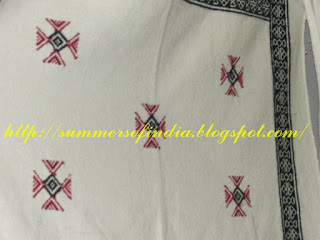Toda is tribal embroidery from the Southern State of Tamil Nadu. The tribe known as Todu inhabit the Nilgiri hills. Both men and women wear a shawl known as"Puthukuli", which is their traditional costume and looks some what like Roman attire Toga. But the way women wear this is different from the way men wear it. The shawl is adorned with embroidered .Heavily embroidered attires are worn during ceremonies and festivities.
About Toda embroidery :
This is a very distinctive and intricate form of embroidery. It is known as"Pugur" meaning flower.The women of the tribe do the embroidery. The ground fabric used is cotton, which is coarse in texture and unbleached-off white colour. The fabric has alternate broad stripes of red and black length wise.,each six inches apart. Embroidery is done in a long, continuous length wise bands between these stripes.
The technique used is an intricate form of Needle Weaving using only one stitch that is Darning. Motifs are worked, by counting the threads. So the beauty of the embroidery depends upon the precision with which these ladies count the threads of the fabric and then embroider.
Embroidery is done from the back side of the fabric using a long darning needle, weaving a short distance, turning around the fabric and weaving the thread back. The embroidery is so finely executed that it looks like weaving. Embroidery is reversible and Todas use the rougher under side of the fabric as the right side.
The patterns used are geometric, reflect Macedonian influence and are inspired by the nature; Sun, Moon, stars, flowers, snakes, etc. Buffalo horn is widely used motif. Other motifs used are Izhadvinpuguti, which is a motif named after their priest, mettvi kanpugur is a box. Rabbit ears is always embroidered at the edge of the fabric to avoid it from unraveling itself. These days the embroideries are not just restricted to shawls but also to borders, table mats, bags, pouches and other such articles are made for tourists. But this art is dying and may vanish altogether if not properly safeguarded.
Toda woman wearing the Puthukuli
These are some of the wares on display at a recently held exhibition

See the red and black embroidery and the motifs used
I spoke with the person managing the stall. He gave the above information.
I just could not resist buying two bags and some borders
These are the bags, I bought from the stall.
Another pattern on the bag below
This is the waist coat with the embroidery
This is a skirt below with the embroidery
These are the borders which I bought. These can be used as attachment to a blouse or a tunic.
Somehow I don't feel like cutting them up and using. I may retain them in my album of textiles and embroideries.
Just look at the beauty of the hand work.
Below the design on the reverse. It looks like its woven.
So how do you like it? let me know please.














